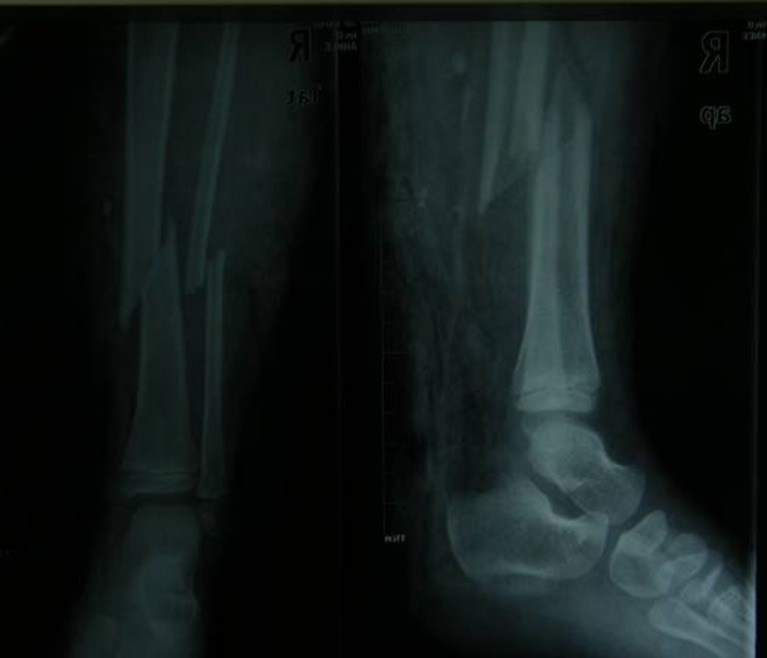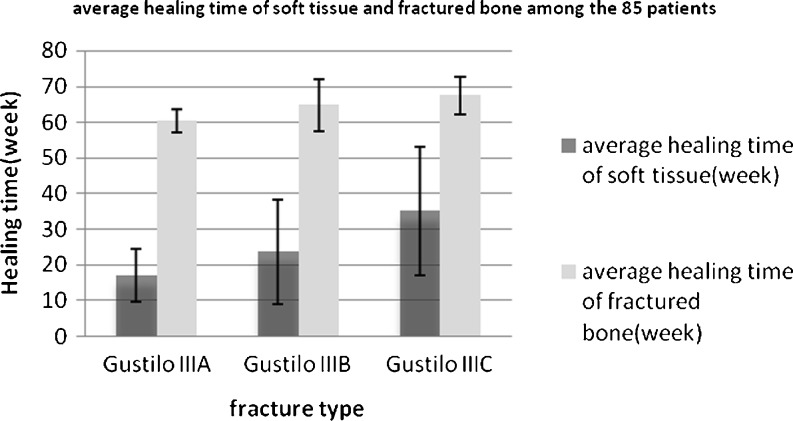Abstract
Purpose
The purpose of this study was to review the results of external fixation combined with vacuum sealing drainage (VSD) to treat patients who sustained tibial and fibular fractures in the Wenchuan earthquake.
Methods
We retrospectively analysed 179 cases (of which 85 were classified as Gustilo grade III) of open comminuted fracture of the tibia and fibula caused by the Wenchuan earthquake. The patients were followed up for an average of 15 months; detailed records were kept on their function and recovery.
Results
After caring for the life-threatening injuries; fractures were treated by external fixation, with VSD used on the surface or in the cavity of the wound after debridement. Antibiotics were administered on the basis of drug sensitivity test results. After the infection had been controlled and healthy granulation tissue had developed, the patients underwent secondary suture, free skin grafting, or skin flap transfer.
Conclusion
Good results can be achieved when external fixation combined with vacuum sealing drainage were used to treat open comminuted fractures of tibia and fibula in the Wenchuan earthquake.
Introduction
Open comminuted fracture of the tibia and fibula is one of the most common injuries, and is sometimes accompanied by severe wound contamination and damage to skin, soft tissue, vessels, and nerves. It can easily lead to compartment syndrome, bone exposure infection or nonunion [1–4]. This is especially true when dealing with a large group of patients with open comminuted tibia and fibula fractures at the same time [5].
The Wenchuan earthquake (May 12, 2008; 2:28 p.m. local time) was a disaster for China. Orthopedic surgeons faced major challenges in controlling fractures quickly and effectively, repairing tissue defects, closing the wounds, promoting wound healing, preventing infection, and minimising complications. Most of the patients brought to our clinic had severe open or closed bone fractures. The literature contains few reports of the effects of vacuum sealing drainage (VSD) combined with external fixation for patients who sustain fractures in these types of natural disasters.
Our institution admitted and treated 1,410 patients in the wake of the Wenchuan earthquake. Combining external fixation with VSD, we successfully repaired patients’ fractured legs without the use of plates or other forms of internal fixation [6–8]. Vacuum sealing drainage has the advantage of allowing wound healing in a short time and simplifying secondary surgery while avoiding infection [9–13], and the clinical outcome is quite favourable.
Materials and methods
Patients
A total of 85 patients (55 males, 30 females), aged 16–85 years, injured by squeezing, burning or falling, with Gustilo grade III tibial and fibial fractures, were included in this study. The length of time between injury and treatment ranged from 30 minutes to 48 hours, with an average of 12 hours. The length of time between injury and hospitalisation ranged from 12 to 64 hours, with an average of 26 hours. Most patients had multiple injuries, with scores of 15–24 using the injury severty score (ISS) system (Figs. 1 and 2). The crush soft-tissue skin defect ranged in size from 7 × 9 cm to 15 × 20 cm. Detailed patient information is presented Table 1.
Fig. 1.
The X-ray film of one patient in the Wenchuan earthquake. It was classified as type III by Gustilo classification
Fig. 2.
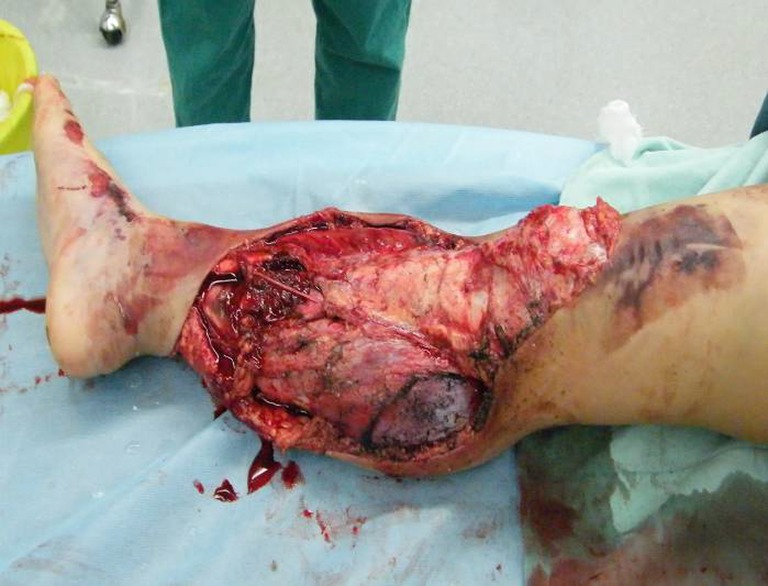
Patient from Fig. 1 injured in the Wenchuan earthquake. It was classified as type III by Gustilo classification
Table 1.
Details of 85 patients classified into Gustilo type III
| Description | Gustilo III A | Gustilo III B | Gustilo III C |
|---|---|---|---|
| Total number (cases) | 15 | 26 | 44 |
| Sex (male/female) | 11/4 | 16/11 | 29/15 |
| Age (years) | 43.9 ± 15.1 | 42.5 ± 18.5 | 44.2 ± 13.7 |
| Delay before treatment (h) | 19.2 ± 7.2 | 23.6 ± 12.8 | 34.5 ± 18.5 |
| ISS score | 19.9 ± 2.7 | 20.6 ± 2.0 | 21.3 ± 2.4 |
| Extension of soft tissue (cm) | 12.9 ± 3.2 | 14.4 ± 3.4 | 14.4 ± 3.2 |
| Combined thoracic injury (case) | 5 | 8 | 12 |
| Combined abdomen injury (case) | 2 | 2 | 5 |
| Combined brain injury (case) | 4 | 8 | 18 |
| Combined nerve injury (case) | 3 | 7 | 11 |
| Combined renal injury (case) | 1 | 1 | 4 |
Materials
External fixators
All external fixators were “Hoffmann II®” devices provided by Constant Science and Technology Ltd. (http://kstdkj.cn.gongchang.com), Wuhan, Hubei, China.
Vacuum Sealing Drainage (VSD)
All VSD devices were supplied by Wuhan VSD Medical Science and Technology Co. Ltd. The materials included a 15×10 × 0.5-cm Poly (vinyl alcohol) shrink formaldehyde bubble and 20 × 15-cm Poly amino acid ethyl ester films. One end of the 30-cm-long 16G silicone drainage tube with side holes was connected to an electric suction bottle with a pressure gauge using three joints. All of the above-mentioned materials were packaged in an aseptic manner.
Treatments
Preparation
We first dealt with life-threatening injuries. When the patient reached a stable condition, we performed surgery on the open fractures. All of the patients were assigned to receive surgery consisting of external fixation combined with VSD after 24 hours.
Surgery
Thorough debridement was performed to remove contaminants and foreign matter and dead tissues (Fig. 3). The length and alignment of the lower limb was restored by manual traction. Crush fracture bone grafts were performed first and were fixed with screws, gram needles, or wires. More than 5 cm from the fracture, the medial side of the tibia received external fixation pins, shelves, and fixed pressure. Patients with comminuted fracture and bone defects underwent traction using the healthy limb or the length of the fibula to assess restoration of limb length and mechanical axis, using the external fixator. Metaphyseal fractures involving knee and ankle underwent external fixation (Fig. 4).
Fig. 3.
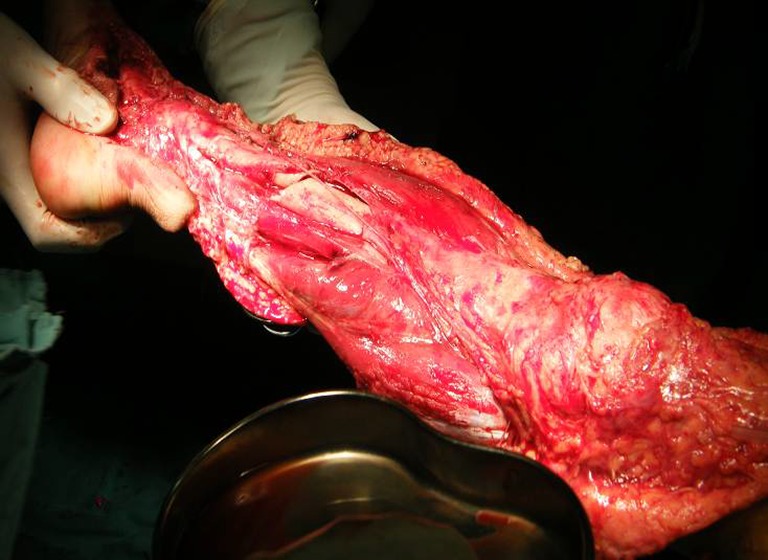
Thorough debridement
Fig. 4.
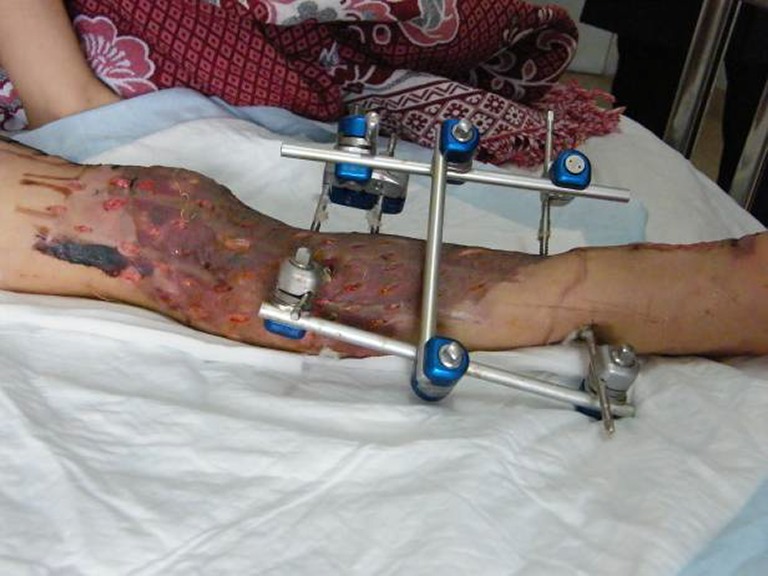
After thorough debridement (Fig. 3), external fixation was used
After initial extensive debridement wounds were covered or filled with a Poly (vinyl alcohol) shrink formaldehyde bubble using 16 silica gel according to the wound size. The Poly (vinyl alcohol) shrink formaldehyde bubble was stuck to the healthy skin, and the wound was then closed with Poly amino acid ethyl ester films. In cases of multiple wounds, the wound drainage tube was connected through various links to the suction device (Fig. 5). Starting after drainage, suction was maintained at 40 kPa for seven to ten days of continuous negative pressure. During this period, no dressing changes were needed. Drainage into the negative pressure bottles was observed, as well as limb swelling, with regression of symptoms noted. After seven to ten days, the polyvinyl formaldehyde foam was removed, wound infection control assessed and a decision was made whether to proceed with granulation and delayed primary closure of wounds, skin grafting, or skin flap wound surgery. If infection was not well controlled, further debridement was performed. Negative pressure drainage was between 500 and 2,300 mL (Figs. 6, 7, 8 and 9).
Fig. 5.
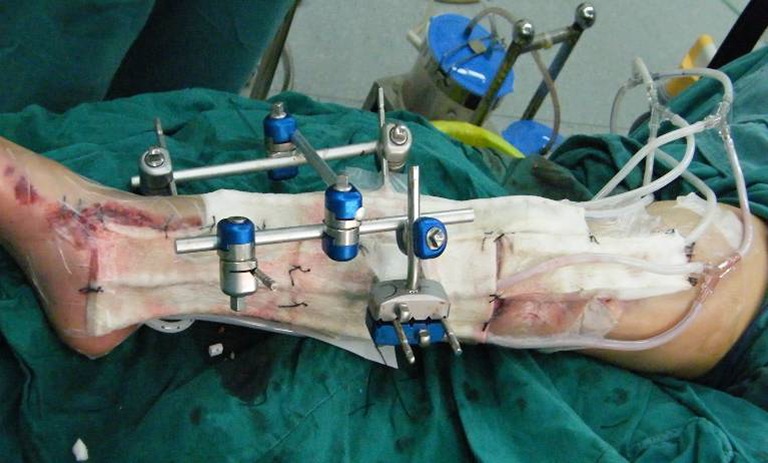
The external fixation combined with vacuum sealing drainage (VSD) were performed after thorough debridement, and the VSD was linked to a negative pressure aspirator
Fig. 6.
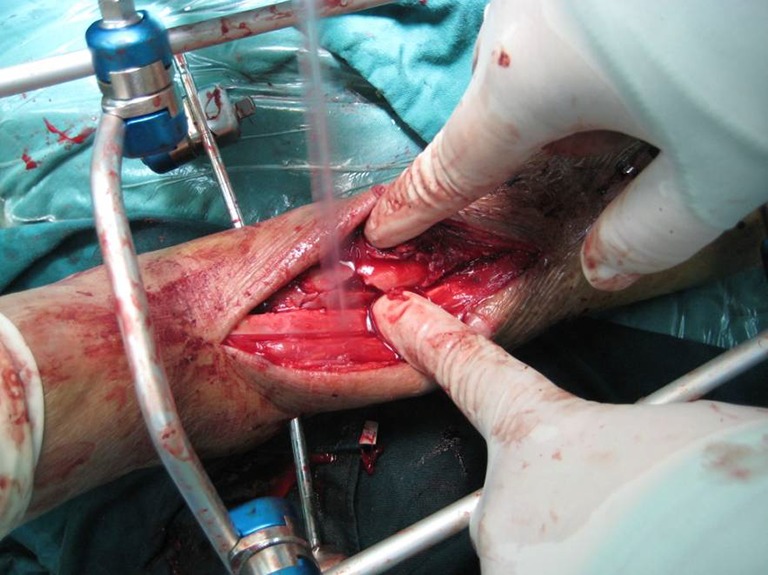
Secondary sutures were followed by treatment with external fixation combined with vacuum sealing drainage (VSD) until the wounds healed
Fig. 7.
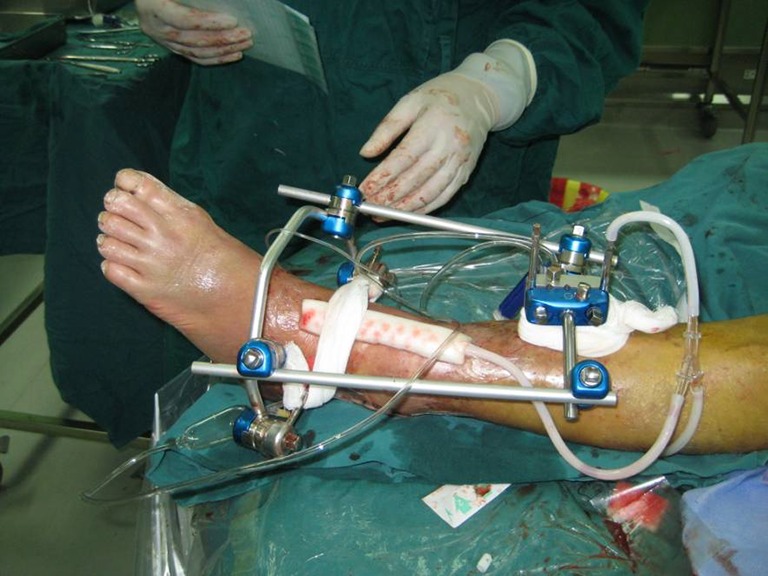
Secondary sutures were followed by treatment by external fixation combined with vacuum sealing drainage (VSD) until the wounds had healed well
Fig. 8.
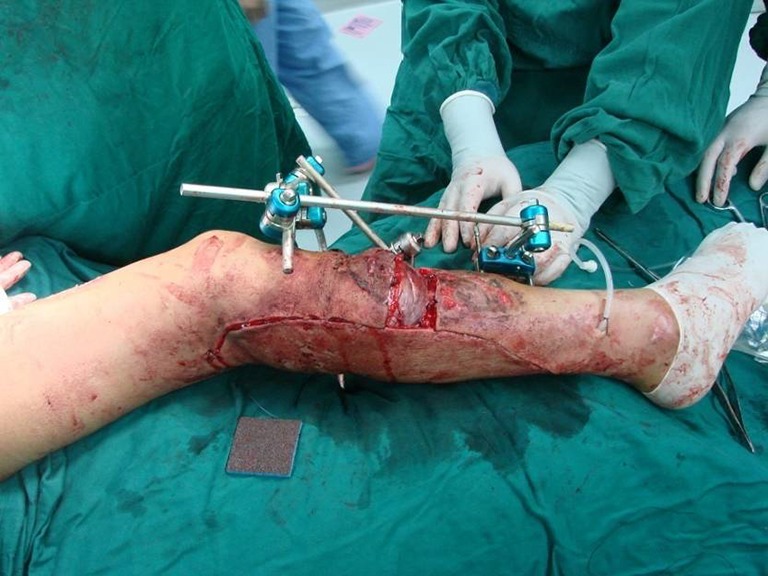
All severely wounded patients underwent transposition off lap after secondary suture, and were then held by external fixation until bone and soft tissue healing
Fig. 9.

All severely wounded patients underwent transposition skin flap after secondary suture, and external fixations maintained until bone and soft tissue healing had been achieved
Postoperative treatments
For ambulatory patients, vacuum suction with negative pressure of 40–60 kPa was used 24 hours per day, while patients who could move freely were treated with a central vacuum bottle (50–60 kPa) while maintaining negative pressure drainage.
Initially, functional rehabilitation of the limb consisted of nonweightbearing movements. When the patient reached a stable situation, weightbearing exercises were gradually introduced. Planning for patients with serious fracture healing of bone should be based on X-rays.
In principle, the selection of antibiotics should be based on the results of bacterial culture and susceptibility testing. Otherwise, high-dose penicillin can be combined with the first and second generation of cephalosporin or metronidazole.
Results
The 85 patients were followed-up for 12–18 months, with an average of 15 months. Patients healed after one month to more than 12 months of treatments; detailed information on clinical results are shown in Table 2.
Table 2.
Clinical results of the 85 patients
| Description | Gustilo III A | Gustilo III B | Gustilo III C | Total |
|---|---|---|---|---|
| Number (case) | 15 | 26 | 44 | 85 |
| Secondary suture (case) | 10 (66.7%) | 17 (65.4%) | 19 (43.2%) | 46 |
| Multiple operations (case) | 1 (6.7%) | 7 (26.9%) | 24 (54.5%) | 32 |
| Pin infection (case) | 1 (6.7%) | 5 (19.2%) | 10 (22.7%) | 16 |
| Dysfunction of ankle (case) | 3 (20%) | 7 (26.9%) | 11 (25%) | 21 |
Additional injuries
In the 85 patients, there were 25 cases of thoracic injury, 30 cases of brain injury, nine cases of abdominal injury, 21 cases of nerve injury, and six cases of renal dysfunction, and ISS scores increased from 15 to 24.
The wounds
After using VSD for seven to ten days, swelling was significantly decreased without any allergic reactions. A total of 32 patients had positive culture results, with most having multiple pathogens. Bacterial culture yielded 19 types of bacteria. The most common were Staphylococcus aureus (four cases), Escherichia coli (four cases), Proteus species (two cases), and Klebsiella pneumonia (four cases). Infection was well controlled, and granulation proceeded well after VSD. When patients reached a stable state, we used direct suturing, grafting, or flaps to close the wounds. Of the 85 patients, 46 (54%) received direct suturing at the second stage of surgery, while nine received local flaps and 30 received grafting. All of these patients completely healed (Figs. 10 and 11).
Fig. 10.
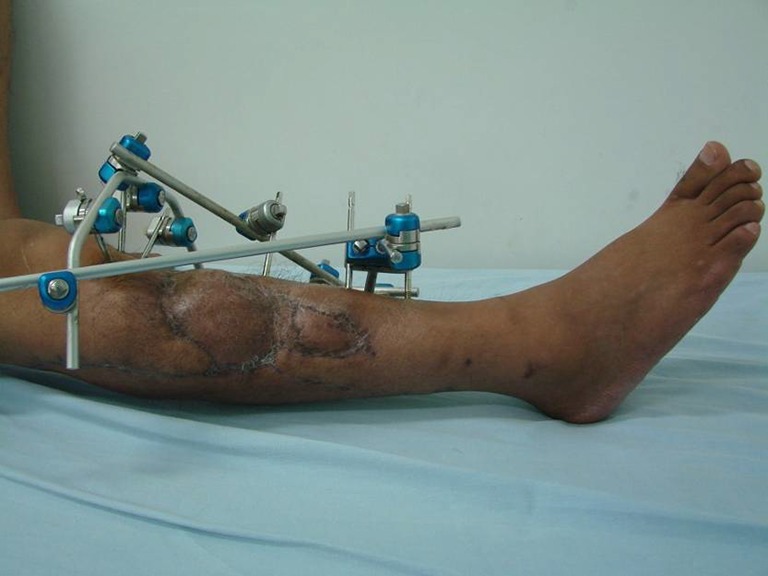
Healing of the transposition laps
Fig. 11.
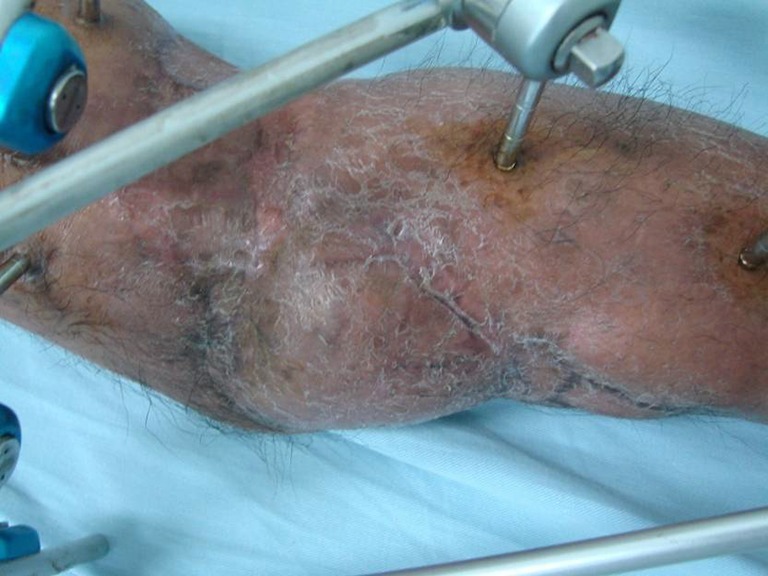
Healing of the transposition flaps
Morphological observation after vacuum sealing
The dead cavity was observed to disappear when the wound decreased by an average of 20% (range, 13–25%), and granulation was flat and fresh, capillaries were rich, the wound bled, and granulation was not oedematous but developed only on the outside. No bacteria were detected by bacterial culture.
Fixation time and infection
The fixation time was four to 12 months, with an average of 5.8 months. No cases of deep infection or osteomyelitis were observed. About ten patients (16 pins) experienced pin-tract infection, but there were no cases of loosening.
Soft-tissue and bone healing
Of the 85 patients, 64 were treated by anatomical realignment, while eight patients required resetting. No angulation greater than 10° or shortening more than 2 cm was observed. In evaluation of fracture reduction, an angle of less than 5° was considered excellent, an angle of 5–10° fair, and an angle of more than 10° is poor. The average healing times for soft tissue and bone were 25 weeks and 64 weeks, respectively (Fig. 12).
Fig. 12.
Average healing time of soft tissue and fractured bone among the 85 patients
Functional recovery of the knee and ankle
About 21 of the patients sustained serious injuries to both nerves and muscles. Although the ankle was stiff, they could walk unassisted. The remaining 64 patients had good mobility of the knee, ankle, and limbs.
Discussion
The Wenchuan earthquake occurred in a mountainous area and was of high intensity, resulting in extensive damage and severe injuries. It caused massive open and dirty fractures in calf. The incident was unique in several respects. First, because hospitals in the affected region had been destroyed, it was not possible to help the victims quickly. Second, the victims’ injuries were so serious and complicated that they were difficult to treat. Third, the high energy often resulted in multiple, severe fractures and bone loss. Fourth, many patients’ tendons and bones were massively exposed, making the wounds difficult to repair. Fifth, extensive wound contamination resulted in a high infection rate. Because of the disastrous medical and transportation situation in the affected region, emergency assistance was limited to cleaning and packing wounds and temporary fixation. Many victims did not arrive at hospitals until nearly 26 hours after injury, contributing to the high infection rate. Numerous orthopaedic challenges arose, including the need to make rapid and good decisions about the best way to stabilise fractures, promote wound healing, reduce complications, and facilitate functional recovery.
Stabilising bone fragments and repairing parenchymal wounds are the two key points of Gustilo III open fracture treatment. Stabilising fractures reduces parenchymal extension of the soft tissues lesion, lowers the infection rate, and advances parenchymal resection in addition to maintaining fracture reduction, supporting bone healing, and promoting the recovery of basic body functions. On the other hand, repair of wounds is a basic need and guarantees the rebuilding of bone vascularisation, bone healing, avoidance of osteomyelitis, and bone regeneration [4, 14].
Fracture stabilisation
The treatment of open and dirty fractures of the leg (Gustilo grade III) caused by the earthquake needed to take into account the high risk of infection, gangrene and other injuries. Promptness and reduction of secondary displacement are required. Traction and plaster are not sufficient to stabilise bone fragments. Prolonged lack of motion of broken limbs jeopardises functional recovery and is likely to lead to ankylosis or hinder wound healing. Internal fixation may increase the rate of soft tissue damage and serious infection (degree III). Once infection occurs, internal fixation becomes a foreign body, which inhibits infection control [14, 15].
External fixation technology has yielded satisfactory results in the treatment of open fracture injuries. Its technological characteristics fit the treatment principles for open fracture stabilisation [16]: (1) vascularisation is prevented as much as possible; (2) no foreign matter is left in the wound, and there is minimal damage to the soft tissue, which promotes the prevention and control of infection; (3) it is a simple and rapid operation which is beneficial to wound treatment; (4) it yields excellent stability, which creates a good environment for initial recovery of function. This benefit is especially evident in the treatment of third-degree tibial and fibular fractures. When many injured people are waiting for aid but medical staff and supplies are scarce, simplifying operation methods and reducing operating time while making good use of limited resources means that more people can be saved [17–20].
Wound control
Earthquakes causing tibial and fibular fractures (Gustilo grade III) are usually associated with extensive soft tissue loss. It is difficult to clear up contaminated and necrotic tissue. It is difficult to repair the soft tissue during the first operation, because complicated technology and treatment are usually needed. Additionally, most earthquake victims have dirty, heavily contaminated wounds and suffer from serious stress reactions, leading to a high rate of wound infection. Formerly, wounds were usually left open after wound cleaning followed by periodical cleaning and dressings [21]. Leaving the wound open for a long period results in wound and cavity flow problems including wound infection, osteomyelitis, long-term parenchymal fixation, poor blood circulation at the fracture ends, increased rate of nonunion, and delay in bone healing. At the same time, the victims’ pain increases.
Vacuum sealing drainage has been initiated since the 1990s; since then, numerous basic research and clinical studies have shown that VSD not only results in complete drainage, helping to keep the wound clean and preventing infection, but also has the ability to reduce the size of the wound, eliminating dead space, stimulating the growth of healthy granulation tissue, facilitating wound healing, and reducing the duration of fixation [22–26]. The mechanism of VSD for prompting granulation growth and accelerating wound healing has been proven at the cellular level.
We used external fixation combined with VSD to treat open comminuted tibial and fibular fractures, which was very effective. We used VSD to cover the wound and at the same time stabilised the fracture effectively; this avoided the risks of high technology fixation required during period I, soft tissues necrosis, high infection rate, and the occurrence of postoperative compartment syndrome. Moreover, we avoided the risks of increased incidence of infection, osteonecrosis, and nonunion caused by prolonged open wound exposure. Furthermore closing the wound space, reducing the surface of the wound, and eliminating bone exposure provided advantages for simplifying period II fixation technology. Moreover, with this treatment the dressing does not need to be changed for seven days, significantly reducing the workload of the clinic staff. It promotes function of the affected limb and improves the patient’s daily life during convalescence. Most important, this treatment is effective to handle numerous patients with open fractures within a very short time, such as may occur during war or major earthquake.
Acknowledgments
Conflict of interest
We declare that we have no financial and personal relationships with other people or organisations that can inappropriately influence our work, there is no professional or other personal interest of any nature or kind in any product, service and/or company that could be construed as influencing the position presented in this article.
Footnotes
Gang Tan contributed equally to this work.
Contributor Information
Lei Liu, Email: gukeliulei@126.com.
Fuxing Pei, Email: peifuxing@vip.163.com.
References
- 1.Sen C, Kocaoglu M, Eralp L, Gulsen M, Cinar M. Compression-distraction in the acute treatment of Grade III open tibia fractures with bone and soft-tissue loss: a report of 24 cases. J Orthop Trauma. 2004;18(3):150–157. doi: 10.1097/00005131-200403000-00005. [DOI] [PubMed] [Google Scholar]
- 2.Caudle RJ, Stern PJ. Severe open fractures of the tibia. J Bone Joint Surg Am. 1987;69(6):801–807. [PubMed] [Google Scholar]
- 3.Dendrinos GK, Kontos S, Katsenis D, Dalas A. Treatment of high energy tibial plateau fractures by the Ilizarov circular fixator. J Bone Joint Surg Br. 1996;78:710–717. [PubMed] [Google Scholar]
- 4.Gustilo RB, Mendoza RM, Williams DN. Problems in the management of type III(severe)open fractures: a new classification of type III open fracture. J Trauma. 1984;24(8):742–746. doi: 10.1097/00005373-198408000-00009. [DOI] [PubMed] [Google Scholar]
- 5.Dhar SA, Butt MF, Hussain A, Mir MR, Halwai MA, Kawoosa AA. Management of lower limb fractures in polytrauma patients with delayed referral in a mass disaster: the role of the llizarov method in conversion osteosynthesis. Injury. 2008;39:943–951. doi: 10.1016/j.injury.2008.02.027. [DOI] [PubMed] [Google Scholar]
- 6.Roy N, Shah H, Patel V, Bagalkote H. Surgical and psychosocial outcomes in the rural injured—a follow-up study of the 2001 earthquake victims. Injury. 2005;36(8):927. doi: 10.1016/j.injury.2005.02.017. [DOI] [PubMed] [Google Scholar]
- 7.Kovacs L, Kloppel M, Geishauser S, Schmiedl S. Vacuum sealing: a new and promising regimen in the therapy of radiation ulcers. Br J Surg. 1998;85:70. [Google Scholar]
- 8.Müllner T, Mrkonjic L, Kwasny O, Vécsei V. The use of negative pressure to promote the healing of tissue defects: a clinical trial using the vacuum sealing technique. Br J Plast Surg. 1997;50(3):194–199. doi: 10.1016/S0007-1226(97)91369-2. [DOI] [PubMed] [Google Scholar]
- 9.Fleischmann W, Strecker W, Bombelli M, Kinzl L. Vacuum sealing as treatment of soft tissue damage in open fractures. Unfallchirurg. 1993;96(9):488–492. [PubMed] [Google Scholar]
- 10.Fleischmann W, Russ M, Westhauser A, Stampehl M. Vacuum sealing as carrier system for controlled local drug administration in wound infection. Unfallchirurg. 1998;101(8):649–654. doi: 10.1007/s001130050318. [DOI] [PubMed] [Google Scholar]
- 11.Beno M, Martin J, Hatzl J. Vacuum sealing in the treatment and prevention of prosthetic infections—a case review. Rozhl Chir. 2010;89(8):508–512. [PubMed] [Google Scholar]
- 12.Fleischmann W, Lang E, Russ M. Treatment of infection by vacuum sealing. Unfallchirurg. 1997;100(4):301–304. doi: 10.1007/s001130050123. [DOI] [PubMed] [Google Scholar]
- 13.Li X, Wang H, Zhang C, Chen K, Zhuang L, Ding B. Repair of skin and soft tissue defects of lower limbs with vacuum sealing drainage combined with flaps. Zhongguo Xiu Fu Chong Jian Wai Ke Za Zhi. 2010;24(6):722–725. [PubMed] [Google Scholar]
- 14.Gustilo RB, MerKow RL, Templeman D. Current concept review: the management of open fracture. J Bone Join Surg Am. 1990;72:290. [PubMed] [Google Scholar]
- 15.Chapman MW, Mahoney M. The role of early internal fixation in the management of open fracture. Clin Orthop Relat Res. 1979;138:120–131. [PubMed] [Google Scholar]
- 16.McKee MD, Yoo DJ, Zdero R, Dupere M, Wild L, Schemitsch EH, Mahoney J. Combined single-stage osseous and soft tissue reconstruction of the tibia with the Ilizarov method and tissue transfer. J Orthop Trauma. 2008;22(3):183–189. doi: 10.1097/BOT.0b013e3181678a64. [DOI] [PubMed] [Google Scholar]
- 17.Barbary H, Abdel Ghani H, Misbah H, Salem K. Complex tibial plateau fractures treated with Ilizarov external fixator with or without minimal internal fixation. Int Orthop. 2005;29:182–185. doi: 10.1007/s00264-005-0638-6. [DOI] [PMC free article] [PubMed] [Google Scholar]
- 18.Ganocy K, 2nd, Lindsey RW. The management of civilian intraarticular gunshot wounds: treatment considerations and proposal of a classification system. Injury. 1998;29:SA1–SA6. doi: 10.1016/S0020-1383(98)90031-6. [DOI] [PubMed] [Google Scholar]
- 19.Shannon FJ, Mullett H, O'Rourke K. Unreamed intramedullary nail versus external fixation in grade III open tibial fractures. J Trauma. 2002;52:650–654. doi: 10.1097/00005373-200204000-00006. [DOI] [PubMed] [Google Scholar]
- 20.Haidukewych GJ. Temporary external fixation for the management of complex intra- and periarticular fractures of the lower extremity. J Orthop Trauma. 2002;16:678–685. doi: 10.1097/00005131-200210000-00012. [DOI] [PubMed] [Google Scholar]
- 21.Panda M, Ntungila N, Kalunda M, Hinsenkamp M. Treatment of chronic osteomyelitis using the Papineau technique. Int Orthop. 1998;22:37–40. doi: 10.1007/s002640050204. [DOI] [PMC free article] [PubMed] [Google Scholar]
- 22.Morykwas MJ, Argenta LC, Shelton-Brown EI, McGuirt W. Vacuum-assisted closure: a new method for wound control and treatment: animal studies and basic foundation. Ann Plast Surg. 1997;38(6):553–562. doi: 10.1097/00000637-199706000-00001. [DOI] [PubMed] [Google Scholar]
- 23.Philbeck TE, Jr, Whittington KT, Millsap MH, Briones RB, Wight DG, Schroeder WJ. The clinical and cost effectiveness of externally applied negative pressure wound therapy in the treatment of wounds in home healthcare Medicare patients. Ostomy Wound Manage. 1999;45(11):41–50. [PubMed] [Google Scholar]
- 24.Tang AT, Ohri SK, Haw MP. Novel application of vacuum assisted closure technique to the treatment of sternotomy wound infection. Eur J Cardiothorac Surg. 2000;17(4):482–484. doi: 10.1016/S1010-7940(00)00349-3. [DOI] [PubMed] [Google Scholar]
- 25.Morykwas MJ, Argenta LC. Nonsurgical modalities to enhance healing and care of soft tissue wounds. J South Orthop Assoc. 1997;6(4):279–288. [PubMed] [Google Scholar]
- 26.Fabian TS, Kaufman HJ, Lett ED, Thomas JB, Rawl DK, Lewis PL, Summitt JB, Merryman JI, Schaeffer TD, Sargent LA, Burns RP. The evaluation of subatmospheric pressure and hyperbaric oxygen in ischemic full-thickness wound healing. Am Surg. 2000;66(12):1136–1143. [PubMed] [Google Scholar]



